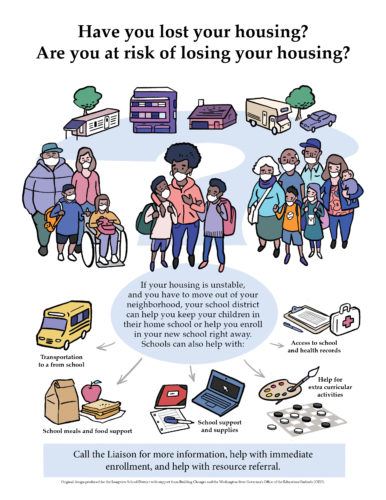
School is starting up this month, and at least 40,000 students — disproportionately students of color — are still living homeless in Washington state. Unsurprisingly, the stress and uncertainty related to housing instability is affecting how these students are doing in school (click here for an analysis of educational outcomes.)
To help support students, youth and families experiencing housing instability and homelessness, each of the 20 school districts in King County has a “homeless liasion” who is designated to answer questions and coordinate services like those pictured above (click here for a list of school homeless liasions with contact information).
McKinney-Vento Education of Homeless Children & Youth Program
The McKinney-Vento Education of Homeless Children and Youth Assistance Act is a federal law that ensures immediate enrollment and educational stability for homeless children and youth. McKinney-Vento provides federal funding to states in order to support local school district programs that serve homeless students.
Homeless Student Stability Education Program
In 2016, the Washington State Legislature passed the Homeless Student Stability and Opportunity Gap Act, to amend state laws related to improving educational outcomes for students experiencing homelessness through increased identification, in-school supports, and housing stability. The resulting Homeless Student Stability Program at OSPI (the state Office of the Superintendent of Public Instruction) complements the federal McKinney-Vento program, providing additional support and resources for local school districts.
Defining Homelessness Among Children and Youth
The McKinney-Vento Act defines homeless children as “individuals who lack a fixed, regular, and adequate nighttime residence,” and provides examples of children who would fall under this definition:
- Children and youth sharing housing due to loss of housing, economic hardship or a similar reason
- Children and youth living in motels, hotels, trailer parks, or camp grounds due to lack of alternative accommodations
- Children and youth living in emergency or transitional shelters
- Children and youth abandoned in hospitals
- Children and youth whose primary nighttime residence is not ordinarily used as a regular sleeping accommodation (e.g. park benches, etc)
- Children and youth living in cars, parks, public spaces, abandoned buildings, substandard housing, bus or train stations
- Migratory children and youth living in any of the above situations
More Information
For more information about support services available, visit OSPI’s Resources For Homeless Children and Youth page; for youth who are disconnected from family, visit the Department of Commerce’s Office of Homeless Youth; and please share Building Changes’ school supports flyer with parents, teachers, and friends.
